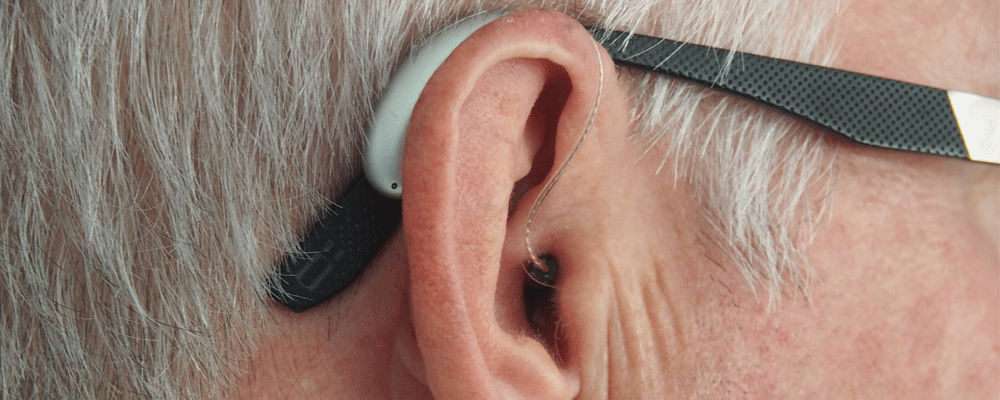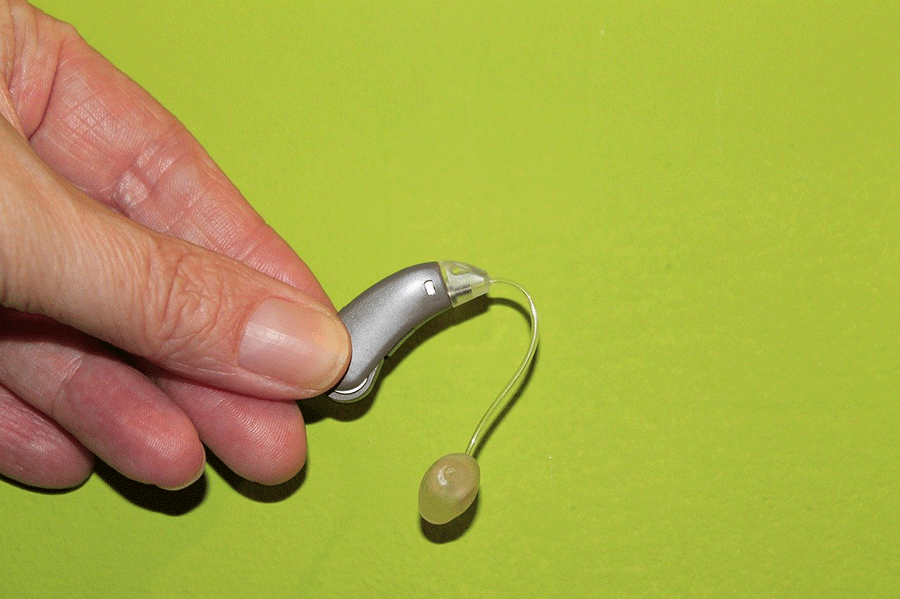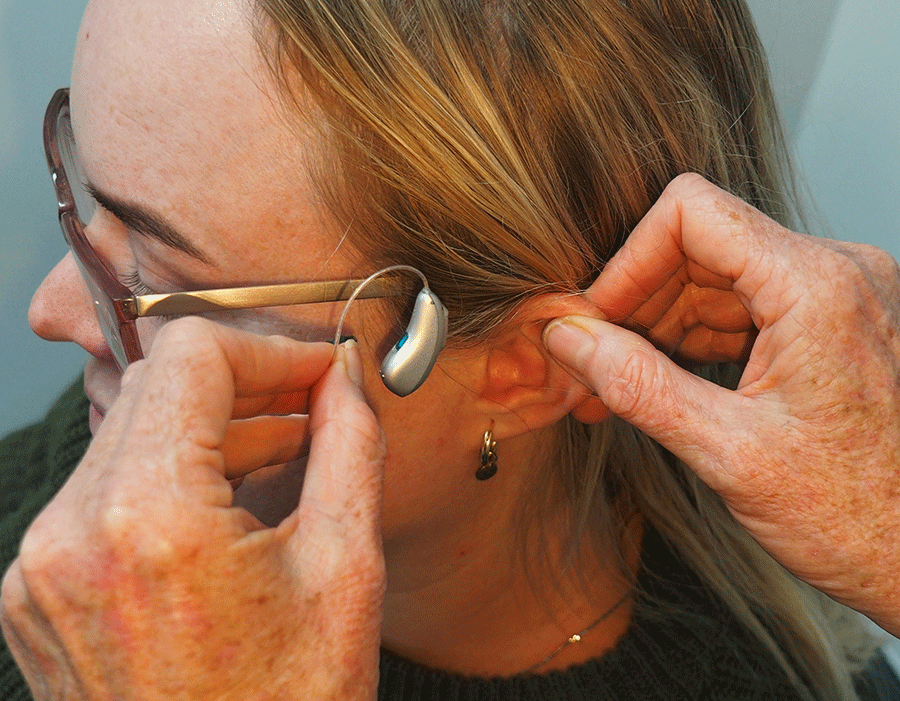Hearing aids have advanced to the point where you can take phone calls and listen to music directly on your hearing device. But experts say that these additions, although convenient, are not exactly good for your health. Why? Because with added wireless connectivity, digital hearing aids have become a powerful source of EMF. In other words, they constantly expose your body, and especially your brain, to massive EMF radiation"Radiation" in the context of Electromagnetic Fields (EMF) refers to the process by which energy is emitted and transmitted through space or a material medium in the form of electromagnetic... More emissions.
When Miller Reese Hutchison developed the first electric hearing aid in 1898 to help his hearing-impaired friend, it revolutionized the medical industry. His design became commercially available in 1913, and it was a huge success. But even though the product worked, it was large and cumbersome for the user.
In 1990, the first digital hearing aid appeared. It was mobile, convenient and the technology used was significantly better than Hutchison’s design. The user experience was way better because digital hearing aids didn’t just amplify sound; they converted sounds into digital signals, processed them, and the final rendition was much more natural sounding.
It wasn’t until 2010 that the idea of adding BluetoothFrom the perspective of someone concerned about the health effects of electromagnetic radiation, understanding Bluetooth radiation is crucial, especially in our increasingly wireless world. Bluetooth technology, ubiquitous in our daily... More technology to hearing aids came into existence. This was when it became a problem.
Why Digital Hearing Aids are a Matter of Concern
If you compare digital and analog hearing aids, you’ll find that digital hearing aids are leagues above analog ones.
Digital hearing aids convert sounds into different signals, and the final sound that you hear is much more natural. They also have depth perception technology, which means that you’ll be able to determine where and how far away the sound-producing object is. Analog hearing aids, on the other hand, worked with volume. You had to manually turn the volume up to be able to adapt to different conditions.

Want to Slash Your EMF Health Risks?
Want to Slash Your EMF Health Risks?
Good! Learn the one small change you should make right now.
If you want to see for yourself, try this: download a volume booster app on your phone, set it to max, and play some music. The sound coming from your speaker will be distorted and sometimes incomprehensible. This is because volume amplification reduces the quality of the original sound. So, since analog hearing aids amplified the sound, the users only heard a distorted and unnatural version of the original.
(Note that if you do this experiment, you should turn the volume down immediately afterwards. Prolonged use of volume boosters can damage your cell phone speakers.)
The basic components of a hearing aid are a mic, an amplifier (amp), a receiver, and a battery. The mic picks up the sounds around you; the amp amplifies the sound, after which the receiver sends the sound into your ear.
In analog hearing aids, the amp worked as a sound booster. But in digital hearing aids, the amp acts as something like a computer CPU. It amplifies the sound, then processes it to be much more natural sounding before sending it to the receiver.
The problem isn’t that it’s digital. It’s incredible that we have such technology which lets people live a normal life despite the situation. The issue here is that modern digital hearing aids can connect with compatible devices like cell phones, computers, and even TVs, making them a powerful EMF source.
The science is clear — keeping non-ionizing EMF sources close to your body for prolonged hours every day can lead to a number of health problems. And if you’ve been with SYB for some time, you’ll know that we urge people to limit their exposure to EMF sources like Bluetooth.
If you’re unfamiliar with the connection between Bluetooth and health problems, you can read more about it in my post “Are Bluetooth Headsets Safe?”.
16 Hours of Radiation Exposure
Digital hearing aids are marketed as low-EMF products, which is actually true. If you use a digital hearing aid for the sole purpose of hearing the sounds around you, then it doesn’t need to emit much EMF.
But on the other hand, if you connect your hearing aid to other electronic gadgets via Bluetooth, its EMF production will no longer be as low as advertised. You’ll have a powerful EMF source right in your ear and hazardously close to your brain.
Now, because wireless connectivity is a super convenient feature, most people keep their hearing aid connected to their cell phone at all times. And this may not be a big problem if you only use your hearing aid for a short time. But the reality is that you have to wear your hearing aid for the entirety of the time you’re awake. Experts, too, recommend that you wear your hearing aid at all times, except when you’re sleeping, so your brain doesn’t have to try and get familiar with interpreting sound in two different conditions.
EMF is strongest at its source. And if you have a powerful source right inside your ear, it increases your chances of developing EMF-induced health problems.
I should reiterate that digital hearing aids are electronic gadgets. So, even if you don’t use the wireless feature, they will still emit EMF. In this case, we can consider that the exposure is justified because hearing aids are a necessity. To compensate for that, you can try to reduce your EMF exposure from other sources.
Ultimately, though, the EMF from Bluetooth connectivity is too much, and using it simply isn’t in your best interest.
Bluetooth & Health
Bluetooth produces EMF in a lesser volume than cell phone devices. Still, the amount is nowhere near safe, and constant exposure can create several health problems in the long term.
But the major concern about Bluetooth devices is not how much EMF they emit but rather the placement of those devices on your body.
Let’s look at Bluetooth headsets, for example. These gadgets connect wirelessly to devices like cell phones, tablets, and computers. They receive the EMF signals from your devices and convert them into sound, which you hear through your earbuds.
The problem isn’t with the sound but the EMF radiation that comes along with it. This EMF gets absorbed by your brain, which can later become the cause of several neurophysiological problems. These problems include neurological cognitive disorders, learning and memory impairment, and sleep disorders.
A hearing aid with wireless connectivity is identical to a Bluetooth headset. When you connect your device to other electronic gadgets, it has no option but to emit large amounts of EMF to communicate with those gadgets’ receivers. Because, when it comes to wireless connectivity, EMF isn’t a bi-product — it IS the product.
SAR: The Unsafe Safety Limit
I visited many digital hearing aid companies’ websites to see if they have explanations on user safety in terms of EMF exposure from their devices. On almost all of them, I got to read the same thing: their devices ‘scored low on the SAR (Specific Absorption Rate) test.’ The numbers were around 0.001 Watts per kilogram. For context, the allowed limit in the United States for cell phones is 1.6 Watts per kilogram.
Governments around the world have set specific SAR guidelines for devices launched in their countries. All EMF-emitting devices, including digital hearing aids, have to be built under those guidelines.
But the problem with SAR is that it doesn’t tell you the amount of radiation a specific device emits. Instead, it tells you the amount of radiation your body absorbs from that device. Theoretically, it’s the perfect measurement because it gives you information on how much EMF your body absorbs from the device. Except, you’re not getting that information at all.
The SAR test is not done on humans. It’s measured on a special test dummy called SAM.
SAM is an acronym for Specific Anthropomorphic Mannequin, and it’s a replica of a 6’2” (1.88 meters) and 220 lbs. (99.7 kg) man. If we look at the statistics, SAM doesn’t represent 97% of the earth’s population. This means if you are shorter and weigh less than SAM, your EMF absorption rate will be a lot higher than what the company tells you.
If you want to learn more about SAR, you can visit my post “What is SAR?”
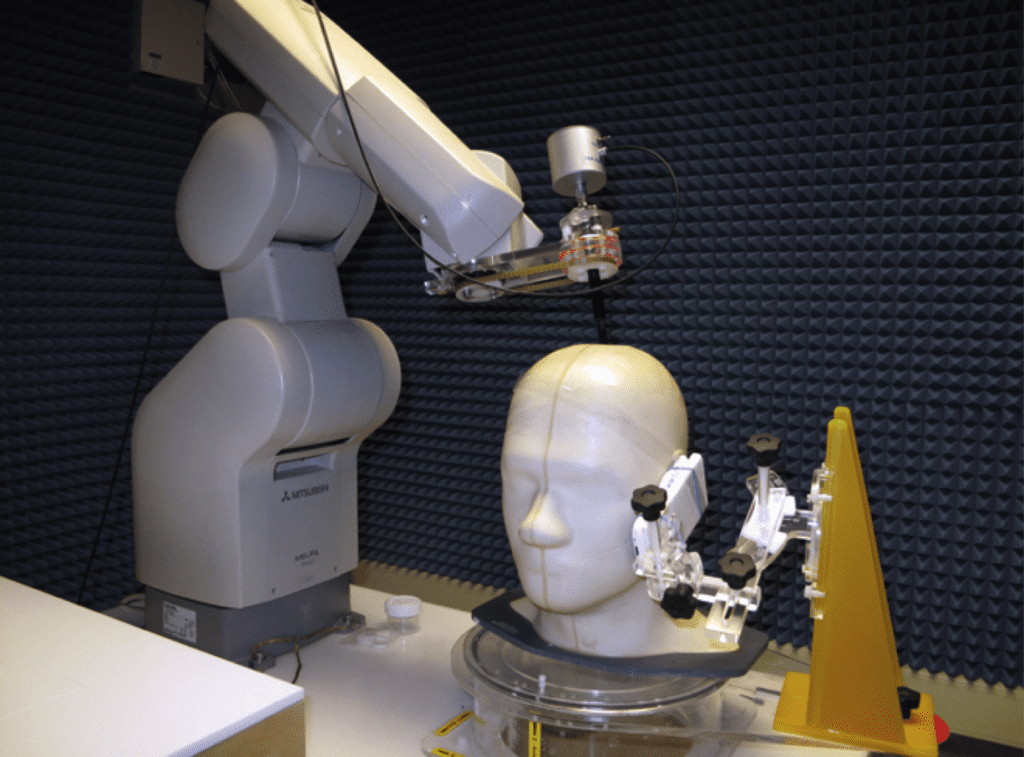
Our current EMF safety guidelines are not exactly safe. So, it’s upon you to decide if wireless connectivity is something that you absolutely need in your hearing aid.
Hearing aids are a medical necessity. And I don’t, in any way, suggest that you shouldn’t use them just because they emit EMF. But wireless connectivity is an added function.
I agree that it’s convenient to stream audio from your cell phone, laptop, and TV directly into your hearing aid. But think about the damage it does to your health – especially your brain.
So, the next time you buy or replace a hearing aid, make sure that the product works in your best interest.
Which Hearing Aid is the Best?
Many of my customers ask me, “Which hearing aid should I get?”.
Now, I can’t comment on the aspect of physical design because that is something very subjective to each individual. But what I can tell you is to search for a device that doesn’t have wireless connectivity. Even if it does, make sure that you can turn wireless off whenever you want.
I’d recommend that you ask the experts to turn off wireless connectivity at the time of your fitting appointment because that’s confusing to do on most hearing aids. If you’re already using your hearing aid, you can visit the store and get it turned off as well.
I also spent some time searching for hearing aids that are on the safer side when it comes to EMF emissions. Have a look.
Best Low EMF Hearing Aids Available
While looking for low EMF hearing aids, I found that it’s now very difficult to find ones that don’t contain Bluetooth or any kind of wireless connectivity. That seems to be the norm now.
After much searching, I found four hearing aid devices that appear to be much safer than most modern hearing aids in the market.
Note: The products I’ve mentioned below are not affiliated with SYB, nor have they sponsored this post, and we do not receive any revenue or commission from them. I also recommend that, before you buy, you contact the manufacturer to confirm the specifications and check that their products and policies meet your requirements.
iBstone
Founded in 2017, iBstone is a professional health care brand that offers high-end health care products and services at a highly affordable rate. Even though they’re relatively new, their consumer base is all around the globe. And every year, iBstone exports thousands of products to different countries.
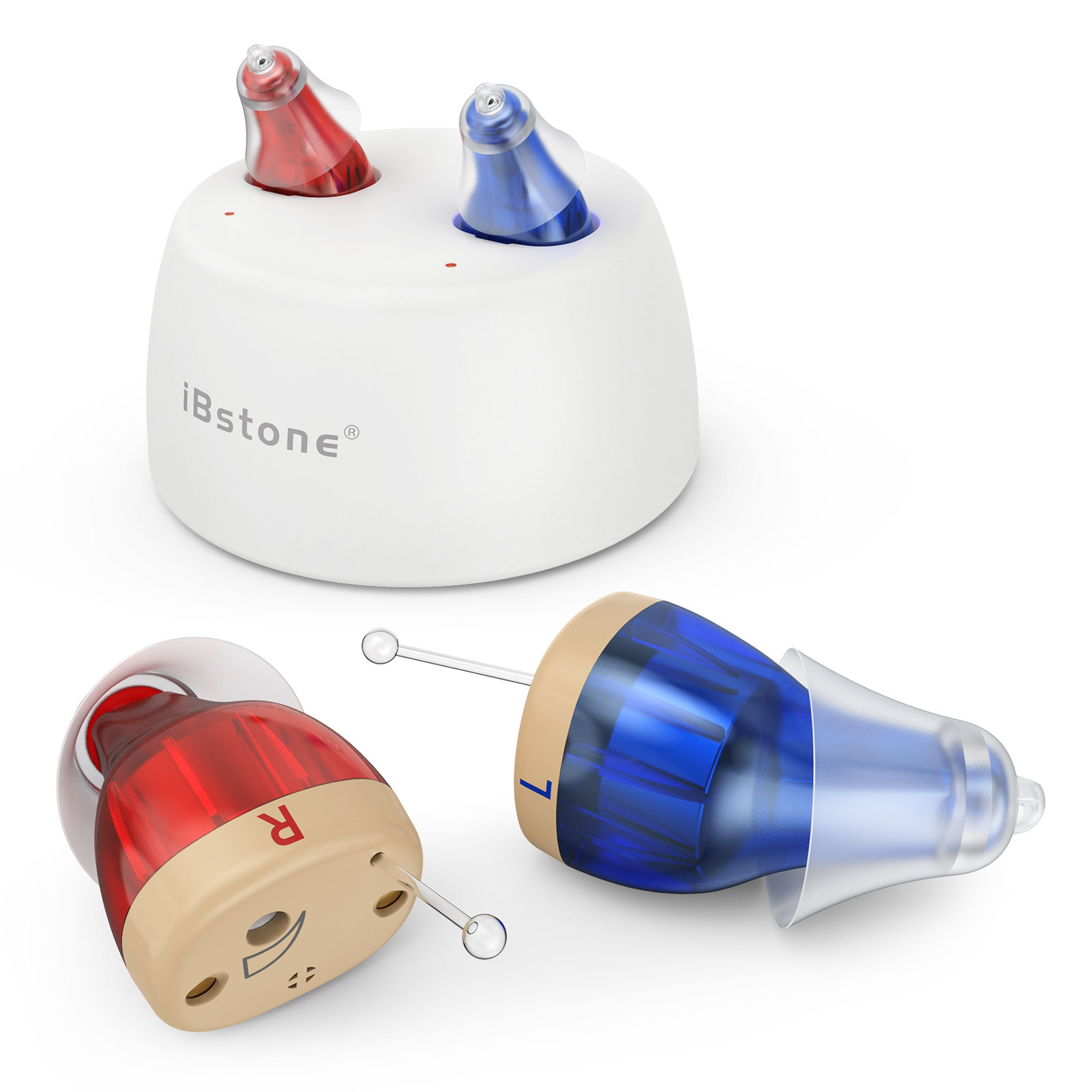
The one that caught my attention was the iBstone K17 Hearing Aid. It’s designed for people with mild to moderate hearing loss, and it’s reportedly super comfortable in your ear canal as it only weighs 2 grams. Additionally, its in-ear design gives you a seamless experience even if you wear glasses.
As a bit of a cherry on top, it’s rechargeable. So, no worrying about changing the batteries anymore.
The reason why I picked this one is because of its design. It has premium-grade hearing support without any extra stuff like Bluetooth or other forms of wireless connectivity. You can find this product on their website, iBstone.net, or you can get it from Amazon.
MD Hearing Aid
Based in Chicago, MD Hearing Aid manufactures one of the best premium-level hearing aids available in the market. Their recent Volt+ model is quite interesting. It claims to contain state-of-the-art audio quality and noise management. And on top of that, it’s also water, dust, and moisture resistant.
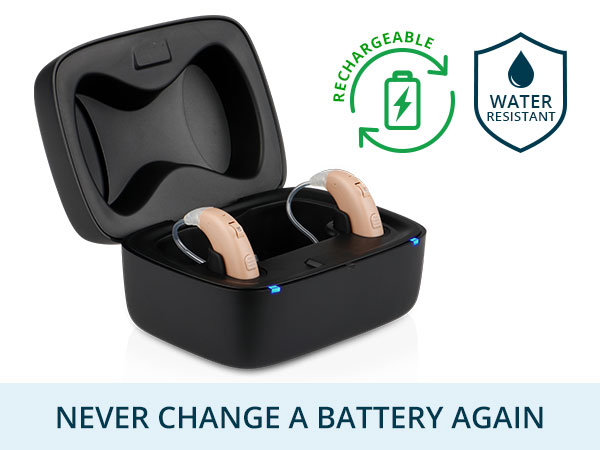
Since Volt+ is one of the premium hearing aid models, its sound quality is of the utmost priority for MD Hearing Aid. This is why they’ve added two directional microphones that help differentiate between background noise and the sound that you actually want to hear. With this hearing aid, you should have no problems hearing properly in noisy environments, like restaurants and social gatherings.
Plus, they have a 45-day free return policy which lets you try the product without having to worry about being stuck with it if you don’t like it. You can get your own piece or pair of Volt+ devices on MDHearingAid.com or Amazon.
One Elephant
With large capacity lithium batteries and 50 hours of backup on a single charge, One Elephant’s Pocket Hearing Aid is one of the most convenient hearing aids around.
Although it’s not a premium product, they claim that Pocket Hearing Aid offers better sound gain than most ordinary hearing devices. It’s suitable for patients with any level of hearing loss. Besides that, this hearing aid has a manual fine-tuning system that lets you personalize the sound based on your comfort level.

One Elephant’s Pocket Hearing Aid is one of the very few wired hearing aids on the market. The only downside is that you have to keep the receiving device clipped to your belt or inside your pocket. But experts would say that this product is worth the slight inconvenience because, since it works like a wired headset, it reduces the amount of EMF emissions that reach your brain.
You can get One Elephant’s Pocket Hearing Aid on Amazon.
ShineWings
Excellent sound quality and comfortable listening—these are the primary requirements of a hearing aid, and they’re exactly what ShineWings promotes with their Hearing Aids for Seniors.

According to ShineWings, their 6th Generation dual-chip control frequency"Frequency" in the context of electricity, Electromagnetic Fields (EMF), and wireless communication, can be thought of as the number of times something happens in a second. Specifically, it refers to... More and double noise reduction technology make for a seamless hearing experience.
The battery is also impressive: the manufacturer says that this device lasts 80 hours on a single charge.
You can get this product directly delivered to your home through Amazon.
Your Turn
We’re in the age where EMF exposure is not optional. It’s literally everywhere, and most sources that emit EMF are not in our control. So, it’s important that you do everything you can to bring your exposure down to a level where it’s safer for your health and wellbeing.
Your hearing aid is a significant part of your daily life. So, getting one that emits less EMF or turning off wireless connectivity will help you a lot.
Besides this, there are few other things that you can do to reduce your EMF exposure further.
Practice Grounding
You may have already heard about the term grounding or earthing. It literally means to be in direct contact with the earth’s surface. Grounding has gained massive popularity in recent years, and it actually has amazing health benefits.
See, we humans are electrical beings. Our brain controls our body by sending electrical signals through the neuronal channel. This is one of the reasons why we’re sensitive to human-made EMF.
Our earth, too, is electromagnetic. Millennia of evolution have taught our bodies how to cope with the earth’s electromagnetic fields and benefit from them. The practice of grounding takes advantage of this phenomenon which in turn gives you the nature-intended health benefits.
If you want to learn more about grounding, I have a separate post that explains it in detail.
Minimize Use & Maximize Distance
The best EMF protection is having no EMF sources around you. But that’s almost impossible nowadays. So, instead of aiming for no EMF exposure, aim for less EMF exposure.
I often get asked, “What’s the best way I can protect myself from EMF’s harmful effects?” and I reply with, “Minimize your tech use and maximize your distance from tech gadgets.” This is the only tip you’ll need to bring your EMF exposure down dramatically. You can certainly use lab-tested EMF shielding products, but they’re more of an enhancement to your efforts to reduce your EMF exposure further.
Start with reducing your gadget time to its bare minimum. This means doing things like putting your phone down instead of endlessly scrolling your social media feed just because you’re bored. Also, turn your WiFi router off when not in use (e.g., when you’re sleeping).
As soon as you start minimizing your tech usage, there’ll be a significant reduction in your EMF exposure, which means that you’ll be less prone to developing EMF-induced health problems.
Besides this, maximize your distance from EMF-emitting gadgets as well. The power of EMF weakens dramatically with distance. So, the farther you are from your gadgets, the safer you’ll be.
To achieve this, you’ll need to change a few of your habits. Here’s a few things you can do:
- Carry your cell phone in a bag instead of your pocket.
- Use your laptop on a table instead of your lap.
- Take calls on speakerphone instead of placing your phone against your ear.
- Use wired headsets instead of wireless.
Also, make sure that your WiFi router stays at least 5 meters away from your body. If that’s not an option, hardwire your internet connection and turn off your router.
Educate Yourself
EMF is a complex subject. So, it’s easy to misunderstand things and fall prey to misinformation. But, the result of that can be life-changing. This is why you must educate yourself from sources that communicate real science to you in a language you understand.
SYB has tens of eBooks, hundreds of posts, and many videos covering topics like EMF’s function and EMF shieldingEMF shielding refers to the practice of reducing the electromagnetic field (EMF) exposure in a particular area by blocking or altering the electromagnetic waves with barriers made of conductive or... More to EMF-induced health problems and protection.
We understand that the physics behind EMF and the biology behind EMF-induced health problems can be somewhat daunting. This is why we take these complex topics and simplify them for everyone to understand. You can read these resources right away for free on my website. I recommend you start with SYB’s Healthy Living Tips.
